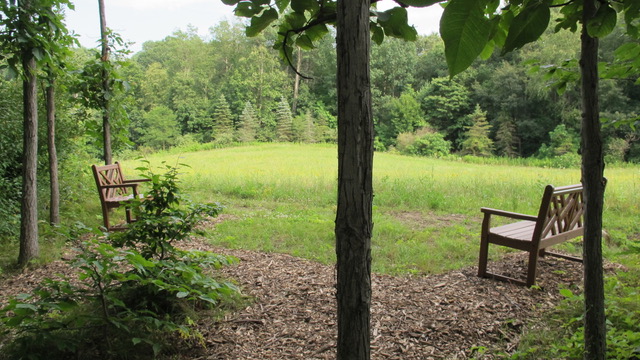
While walking the trails at The Hermitage, you may come across two seating areas, each with a bench and a single chair, nestled into the edge of the woodland overlooking a short-grass Prairie. The grasses, sedges and abundant wildflowers in the Prairie provide a home to butterflies and other insects, birds, and small mammals. Deer and other larger animals find forage and prey in this verdant place.
The first Prayer Garden is dedicated to the memory of Gertrude Bailey Ruder, whose life of prayer and careful concern for living things we honor by this placement of a bench and chair, plantings of bulbs, flowering shrubs and the gathering of nut trees in this natural clearing on the edge of what was once the middle of a wooded area.
The second garden sits on a hill overlooking the trails and much of the wildlife that has come to call this prairie home. This area also has a bench and a single chair situated under the shading branches of a white oak that will hopefully become the dominant tree on this forest edge.
What you cannot see under the Prairie are three fossil fuel pipelines. The first, was initially constructed in 1968. This pipeline was retired in 2014 after a massive rupture in 2010 dumping over 800,000 barrels of crude oil into the tributaries of the Kalamazoo River.
The second pipe, carrying natural gas, was installed in 1999. The gas runs at a rapid rate through this 4-foot diameter pipe. Friction inside the pipe heats the surrounding soil so that the snow melts first here each winter often leaving a stripe of bare land.
The third pipe is actually a “replacement” for the first pipe. The new pipe, is two times the size of the first pipeline, carrying millions of gallons of the Athabasca oil sand’s diluted bitumen (dilbit) to the refineries.
As part of our “protest” against both our own way of life and the oil company’s placement of a poison stream under the earth’s surface we planted the Prairie. We also created the two prayer gardens flanking the Prairie.
The placement of these two gardens across from each other, counters the flow of oil and gas through the pipelines. As folks pause to pray, to listen, to watch and learn, they participate in the hope we have for this land: that someday, it will no longer be needed to transport toxic materials to support our unsustainable lifestyles of ease and injustice toward the world’s poor and marginalized. We hope that the Prairie symbolizes our trust that the land will be returned to its more productive use of sustaining all kinds of life. As we pray “across” and “against the flow” may we find what actions we can do in our own lives to send the message to international oil and gas companies that this pipeline is not “needed.”
Naomi Wenger
